 Many people these days use a Wi-Fi (IEEE 802.11) router, or they have a broadband modem with built-in wireless. It’s amazing to me that in this supposedly “high-tech” and “high-security” age, many people still are completely unaware just how wide open their home network really is.
Many people these days use a Wi-Fi (IEEE 802.11) router, or they have a broadband modem with built-in wireless. It’s amazing to me that in this supposedly “high-tech” and “high-security” age, many people still are completely unaware just how wide open their home network really is.
With a Wi-Fi modem, usually your provider will be smart enough to lock down your wireless connection for you. But if you bought a wireless router or access point and set it up yourself, there are a few things you should know to keep others from “stealing” your connection and using it for nefarious purposes…
If you use a Wi-Fi-enabled broadband modem, check with your service provider or the manuals that come with it to figure out how to make sure things are nice and secure.
On the other hand, if you bought your Wi-Fi box yourself and set it up, you may have made Mistake #1: Plug and Play, baby! Sure, it DOES work right out of the box. But that usually means that you are using WEP, or Wired Equivalent Privacy. It turns out that severe security holes in WEP were identified way back in 2001. It’s a piece of cake to hack into a “WEP-secured” network.
Fortunately, there are other options, although it takes a bit of actual work. And yes, you might have to read a manual. Don’t worry – it’ll be worth it. Besides, I’m hoping to get you started so that you’ll be prepared for any strange acronyms and obscure technical terms you might encounter.
The most common alternative to WEP is called WPA2, aka Wi-Fi Protected Access. Although certainly not bulletproof, WPA2 is a much, much better alternative to WEP.
So, the first thing you need to do is access your router’s configuration page. Usually this is accomplished by pointing your browser to the URI: http://192.168.0.1/ or something along those lines. Check your manual!
I should note here that the following instructions are necessarily vague. Obviously I can’t give detailed instructions on how to set up every Wi-Fi router ever made, so I’m just going to try to give a nice overview that should help you get started.
Alrighty, where were we… Ah yes: After logging in, you’ll want to find something like “Wireless Configuration”. Sometimes you first have to go into a “Configure” page, and then you’ll see the link to configure the Wi-Fi settings.
The basic Wi-Fi settings page will probably include things like Mode, Band, ESSID, and Channel. The only one you should really have to pay any attention to is the ESSID. The ESSID is the name of the network that you will need later in order to set up the connection on your computer.
Once you’ve poked around the basic Wi-Fi settings, you’ll want to then locate the “Advanced” or “Security” options, and find some mention of WEP and WPA2.
You’ll want to make sure that the system is NOT using WEP, and is instead configured to use WPA2. This is often listed as:
- WPA2-PSK
- WPA2-Personal
“PSK” stands for “Pre-Shared Key”. “Personal” refers to the same thing. This is the mode you’ll want to use, since you probably don’t have a Wi-Fi authentication server on hand since you aren’t a giant corporation. The “Personal” or “Pre-Shared Key” part basically just means that you’ll enter a secret code, which you will then have to use to access the network from your computer the first time you connect to the wireless router/access point.
There will probably be some sub-options to go along with your choice of WPA2. If you are given the choice of AES, TKIP, or AES+TKIP, choose AES. TKIP is an outdated encryption scheme, whereas AES is relatively secure. You might want to pick AES+TKIP to maintain backwards compatibility if you’ve got some computers with older Wi-Fi cards and/or drivers. If you can, it’s better to upgrade your Wi-Fi cards/drivers in the old-school computer!
At this point, find the “passphrase” or “password” or “code” box or whatever they’re calling it, and type in your Top Secret Code. Make it something good – the longer the better. In fact, you’ll probably want to check out my post on creating secure passwords. Note that you will not have to type this code in every single time you connect to your wireless network, so it’s actually better if it’s much longer than a normal password.
Okay, you’re almost done.
There will be another option in the settings somewhere called “Broadcast ESSID”. If you enable this option, your Wi-Fi box will sit there and advertise itself continuously to the whole world. In other words, it will send out its identifier to computers within range saying, “Dudes! I’m a wireless network, wanna use me?” The ESSID broadcast should be turned off so that people can’t even see that you have a Wi-Fi network running. When you go somewhere public and suddenly you can see available wireless networks, that’s because the Wi-Fi access point is broadcasting its ESSID.
One last thing to do: Find the Wi-Fi option called something like “Access Control” or “ACL”. This page will give you a screen that allows you to enable Wi-Fi access for only specific Wi-Fi adapters. What you want to do is allow only those MAC addresses that you enter. A MAC (Media Access Control) address is like an IP address, except that it’s supposed to be unique to the specific Wi-Fi adapter in your computer. Even if two computers have the same make and model of network adapter, their MAC addresses should be different. To find the MAC address of your Wi-Fi adapter in Windows, do this:
- Open a command prompt window (Win-R, then type
cmd, then hit enter) - Type
ipconfig /alland then hit enter - Find the section with a “Description” that involves the terms “wireless” or “WiFi” or “802.11”
- Underneath the “Description”, there will be a “Physical Address” line with something that looks like:
01-2A-4F-16-97-B4 - Write that weird-looking string of characters down – it’s your Wi-Fi adapters MAC address!
Now, back in your router’s Access Control configuration page, enter your MAC address and allow it access. You have just configured your router to only accept Wi-Fi connections from your specific wireless card in your specific computer. No one else will be able to access it, even if they have your ESSID and Top Secret Code. You’ll need to repeat the above MAC-address-finding procedure for all computers that you want to allow to access to your Wi-Fi network.
Now you can save your router’s configuration. Usually it will make you reboot the gizmo. Let it reboot.
When it’s done, go into your OS and set up a new WiFi connection. Be sure to select the option “Connect even if network is not broadcasting” or something along those lines. That tells your computer that your Wi-Fi router or access point is not broadcasting its ESSID, so it will have to just take your word for it and try to connect anyway. When the ESSID broadcast is turned off, your wireless network will not show up when your computer searches for local wireless networks! Don’t worry, it will still work since you’ve set everything up brilliantly.
In Windows XP and Vista, you’ll have to set up a wireless network manually since the ESSID is not being received by your computer. You’ll have to select WPA2-Personal, enter the ESSID, choose AES for the encryption, tell windows to connect even if your router isn’t broadcasting, and finally enter your Top Secret Code. Then, try to connect!
If it doesn’t work, don’t panic. One thing you can do is remove the MAC address Access Control and re-enable the ESSID broadcast. This will allow the network to show up automatically on your computer, and you’ll be able to connect more easily. Once you have connected, disconnect, change the settings in the router back to the way they were before (no ESSID broadcast, MAC access control on), and try again after tweaking your wireless connection settings on your computer to account for the now-enabled “no ESSID broadcast” option. This is a good way to troubleshoot in case your computer has bigger problems like a bad Wi-Fi card, a wonky driver, etc.
Okay, so this all sounds really complicated. And, well, it kind of is complicated the first time you do it. But there is a good reason for all of it.
First, you are using WPA2 with AES, which is far more secure than WEP. Then you added to that the “do not broadcast ESSID”, which basically put your Wi-Fi network into “stealth mode”. And then, on top of all that, you have another layer of protection in the form of MAC address-based access control. If you successfully set all this up, your wireless network will be far more secure than most out there! And then you can go tell everyone what a genius you are!
Finally, a few notes about real security vs. imagined security…
Assume that any publicly available encryption scheme is easily hacked by those with the proper tools. You are never 100% safe. You have never been 100% safe, so this shouldn’t come as a shock to you. You could keel over dead in the middle of this sentence. Such is life.
Also, MAC addresses are not a bulletproof way to identify a computer’s network hardware. MAC addresses can be “spoofed”, i.e. changed. Theoretically, I could change the MAC address of my laptop’s Wi-Fi adapter so that it looks like your laptop as far as your router is concerned.
And just because your Wi-Fi router/access point isn’t broadcasting doesn’t mean that people can’t see it – if they know how! It just means that most people can’t see it.
That’s the whole point of this exercise: you are making your Wi-Fi connection as secure as possible in order to make yourself less of a target to annoying people who want to cause you trouble. You won’t be surfing inside an impenetrable force field or anything like that. You will simply be safer than most people, not only because you have multiple layers of basic protection, but also because you have a lot more knowledge about how these things work.
A little knowledge can go a long way!




Recent Comments